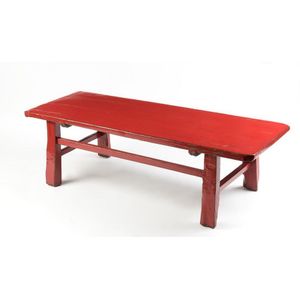French Oak Refectory Dining Table
A French oak refectory dining table, the plank top with clenched ends and raised on a refectory base, solid turned legs one with the furniture maker's mark of a flower. Top requires minor attention. 214 x 107 x 78 cm.
You must be a subscriber, and be logged in to view price and dealer details.
Subscribe Now to view actual auction price for this item
When you subscribe, you have the option of setting the currency in which to display prices to $Au, $US, $NZ or Stg.
This item has been sold, and the description, image and price are for reference purposes only.
- Turned Legs - are legs which have been turned on a lathe. In use from the 16th century, turned legs on tables, chairs and cabinets became more frequent until, by the 1830s, the Georgian square or tapered leg was rarely found except in country pieces.
- Turning - Any part of a piece of furniture that has been turned and shaped with chisels on a lathe. Turned sections include legs, columns, feet, finials, pedestals, stretchers, spindles etc. There have been many varieties and fashions over the centuries: baluster, melon, barley-sugar, bobbin, cotton-reel, rope-twist, and so on. Split turning implies a turned section that has been cut in half lengthwise and applied to a cabinet front as a false decorative support.
- Refectory Table - A long, substantial, solid-topped table, without leaves or extensions, used as a dining table. They were originally used in the refectories, or dining halls of monasteries, and are found in such places as boarding schools and university halls of residence. The tables usually have heavy turned legs, sometimes connected by stretchers close to the floor, and often have additional supporting legs along the railed frame. The term is also sometimes applied to a much shorter solid-topped table with a somewhat Jacobean flavour of the early 20th century.
- Oak - Native to Europe and England, oak has been used for joinery, furniture and building since the beginning of the medieval civilisation. It is a pale yellow in colour when freshly cut and darkens with age to a mid brown colour.
Oak as a furniture timber was superceded by walnut in the 17th century, and in the 18th century by mahogany,
Semi-fossilised bog oak is black in colour, and is found in peat bogs where the trees have fallen and been preserved from decay by the bog. It is used for jewellery and small carved trinkets.
Pollard oak is taken from an oak that has been regularly pollarded, that is the upper branches have been removed at the top of the trunk, result that new branches would appear, and over time the top would become ball-like. . When harvested and sawn, the timber displays a continuous surface of knotty circles. The timber was scarce and expensive and was used in more expensive pieces of furniture in the Regency and Victorian periods.
This item has been included into following indexes:
Visually similar items

Mid- century coffee table, by Lane Altavista, in mahogany with dovetail detailing, length 138 cm, width 47 cm, height 37 cm
Sold by
in
for
You can display prices in $Au, $US, $NZ or Stg.

Rainer Daumiller (Danish), Dining Table, c. 1970, manufactured by Hirtshals Savvaerk, pine wood, height 72 cm width 200 cm depth 90 cm
Sold by
in
for
You can display prices in $Au, $US, $NZ or Stg.

A Chinese red lacquer side table, circa 1920, 43 cm high, 144 cm wide, 53 cm deep
Sold by
in
for
You can display prices in $Au, $US, $NZ or Stg.

An Australian cedar carver chair, 19th century
Sold by
in
for
You can display prices in $Au, $US, $NZ or Stg.
